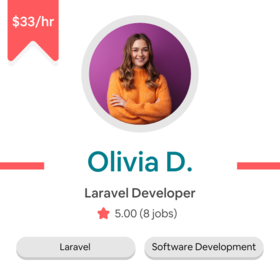













You want to build a beautiful app that’s also reliable, intuitive, and effective for macOS users. You need a developer with skills and talents in UI design and back-end data structure.
Many apps that used to be available only to iPhone and iPad users are now accessible on macOS as well. The opposite is also true, just like what Google does to most of its web-based services, such as Docs and Drive. Apple has been consistent in its attempt to create a massive ecosystem where any app that's natively built for macOS desktop should also work, or at least share features and functionalities, with the company's mobile devices. The same thing also applies to third-party apps. If your company is building a macOS app, you might as well make one that follows Apple's guidelines. Your competitors are doing exactly that, so there's no reason to get left behind.
Interoperability and compatibility across Apple's platforms sounds great to users, but quite a challenge to the companies building the apps. But it's never a challenge too monumental to overcome as long as you hire the right developer for the job. And that's the reason we're here. Cad Crowd can help you search for the most competent candidates nationwide and deliver them to your door.
Some companies have different takes on what constitutes a competent developer, and you have the freedom to choose which developers to hire. We also have our own opinions about that. Think of it as a suggestion, and it only gives us pleasure to share it with you. When you give Cad Crowd the chance to be of any assistance, here is how we prioritize some freelance programmers and developers over others.
While some developers do work alone, the vast majority build apps in a collaborative setting with project managers and other developers. Communication is the key to a manageable workflow, prompt deliverables (which includes the minimum viable product or MVP), and effective troubleshooting, among others. Active contributions to scheduled progress presentations and bug tracking are also important, so being able to work in a cohesive and collaborative manner is a crucial trait of a good macOS developer.
It's a known fact that developing an app for macOS is not an easy undertaking. No developer, regardless of how skillful the person might be, gets it right the first time. Most, if not all, developers will run into issues in every phase of the development. Because complications are almost definitely unavoidable parts of the job, proactive communication is imperative to stay ahead of the inevitable. There are times when developers feel like they're isolated – as software development has always been traditionally done in siloed divisions – and that the project moves at their own pace. One of the negative effects is that developers may lose touch with the rest of the team and the client.
To highlight how developers utilize or practice communication, Cad Crowd always makes sure to ask the candidates about their past projects along with the challenges they encountered in those projects in the early (prescreening) interview process. While it's true that not every developer who communicates well is also a good problem solver and that "good communication" alone doesn't do much good at fixing bugs, effective teamwork can only happen when every member fosters a collaborative culture.
Every macOS developer (and all other Apple platforms for that matter) has to know how to write codes in Swift language. Although it shares a lot of similarities with Objective-C, there are also quite a lot of differences; they're not equivalent. When candidates say they understand Objective-C, it doesn't always mean they're equally well-versed in Swift and vice versa. Objective-C still holds a great deal of relevance to the macOS app ecosystem, but this is mainly thanks to its massive repository of legacy codes. However, Swift is gradually taking over, and in fact, it has become Apple's official programming language. Apple encourages developers to write their apps, whether for desktop or mobile operating systems, in Swift. There will be a time in the future when Objective-C becomes truly obsolete, but at this point, it's best for you to hire macOS developers capable of using both Objective-C and Swift.
Being able to write codes in Apple's preferred programming languages makes developers viable candidates. That said, Cad Crowd will only shortlist the talents who can demonstrate an in-depth knowledge of how the languages actually work in the context of the macOS application framework. Some of the questions our recruiters may ask regarding this particular aspect:
Another important quality we look for in a macOS developer is their willingness to keep up with Apple's technological advancements. One of the easiest ways to stay up to date is to attend the annual WWDC, where the company introduces the latest changes to its app development frameworks and tools. Having an active account in reputable developer forums, like GitHub, can also be helpful.
Let’s say you already have a team, and you need an additional macOS app developer or two to bring fresh perspectives to either an ongoing or new project. The new developers should be ready to collaborate with the existing team from the get-go, meaning they actually use or perhaps specialize in the same set of tools as the company. And there’s an abundance of such tools for macOS developers.
Several development environment options are available for macOS app developers. Some of the most popular ones are as follows.
| Xcode | Apple's official integrated development environment (IDE) for every operating system, including macOS, iOS, tvOS, iPadOS, watchOS, and, more recently, visionOS, is Xcode. It is as comprehensive an IDE as you can get to build applications for every Apple product. |
| Visual studio code | A versatile source-code editor not only for macOS but also other major desktop operating systems (Windows and Linux) and web browsers. VS Code is developed by Microsoft. |
| JetBrains AppCode | The IDE is more like Xcode than VS Code in the sense that it's built only for Apple products, specifically the macOS and iOS app development. It works with many programming languages, including Objective-C, Swift, C++, and C. |
Each contains a combination of settings and software tools to streamline application coding, testing, and eventual deployment.
If this is your first macOS development project, you might think that all developers build apps from scratch. Some might be able to do that, but most use the already available frameworks and libraries. Here are a few examples.
| SwiftUI | As the name suggests, SwiftUI is a user interface (UI) toolkit based on Swift. It is designed to allow developers to build apps using declarative (as opposed to imperative) syntax. SwiftUI is compatible with every Apple platform. |
| Cocoa | The native object-oriented API (application programming interface) for macOS. The Cocoa programming environment offers a range of common UI elements, such as scrollbars and buttons, and automates various aspects of application development to comply with Apple’s guidelines. |
| Core Graphics | A framework for two-dimensional graphics rendering. macOS developers use Core Graphics to draw visual elements, including images and shapes, that build the foundation of the application user interface. |
| Core Data | One of the back-end development tools for macOS apps, the Core Data framework offers many features to help developers manage business logic and data storage. It’s an object-oriented middleware for database management. |
In general, frameworks and libraries provide tools, prebuilt protocols, and even pre-written application codes to expedite app development projects. Thanks to the resources, macOS developers never have to reinvent the wheel and simply focus on building the features.
While it's true that macOS developers mainly build apps for Apple's desktop environment, they often have to design the apps for easy integration with other platforms such as iPhones, iPads, Apple Watches, Apple TV, and, of course, iCloud. Every Apple device offers quick access to the cloud storage service, allowing users to back up and synchronize data. As far as cross-device integration is concerned, macOS developers are spoiled with a number of tools designed specifically for this purpose.
| AirPlay | If your multimedia app works with AirPlay, users can stream content from their computers to Apple TV and other compatible devices. |
| Continuity Camera | When you're creating communication or productivity apps, make sure they have Continuity Camera functionality. Continuity Camera was first introduced in macOS Ventura to allow users to fully utilize the cameras on their devices for interoperability purposes. For example, Mac users can mount their iPhones on the desktop monitor and use the camera as a webcam. |
| Universal Apps | It’s almost as good as it says on the tin. Universal Apps can run on Apple Silicon and Intel-based macOS hardware. |
| HomeKit and HealthKit | For apps that offer smart home functionalities and health-related features, the HomeKit and HealthKit frameworks allow users to sync data and access it from multiple Apple devices. |
It’s natural for users to want every app to work on their various devices. The integration tools give developers a practical method for ensuring harmonious macOS app usability and data synchronization on a range of Apple products.
Based on our own experience as a staffing agency for macOS developers over the years, most employers want to hire professionals who always try to stand in the users’ shoes. They can build good apps because they see things from users’ perspectives. Backed with technical competence, such developers can truly grasp both the UI and UX behind the app. Whenever you’re ready to bring talented macOS developers to your team, reach out to Cad Crowd and connect with some of the most competent candidates you’ll ever find.
Are you seeking to elevate your software to the next level of success? Look no further than Cad Crowd, where we can connect you with highly skilled macOS Apple developers who can bring your vision to fruition. Our team is dedicated to providing customized app development solutions that perfectly align with your unique needs. Request a free quote today to discover how our seamless process can simplify development and help you secure the most talented professionals for your project.


